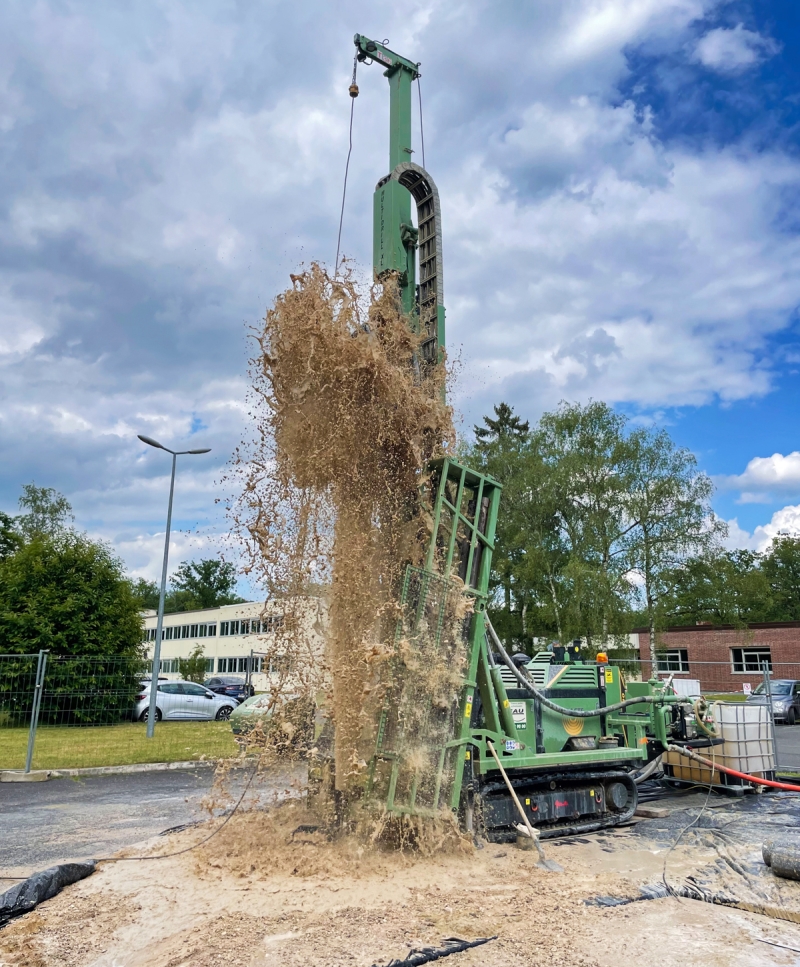For its new laboratories in Orléans, BRGM chose geothermal energy for heating and cooling, through a shaft drilled close to the building. © BRGM
Sustainable development
Clear ambitions for 2030
Promoting a vision, giving meaning and forging an identity: this is how BRGM’s SD & CSR master plan formulates its response to the major challenges of the ecological transition and an equitable society. Covering the period 2025-2030, this document outlines a global, unifying project that embraces all the institution’s activities – research, support for public policy, partnership research, expert appraisal, post-mining management and support activities – and mobilises all its employees.
Drawn up in 2024, this master plan is based on the SD & CSR actions contained in the various sector plans1 that have been implemented and on discussions with stakeholders, in particular the Social and Economic Committee, the Board of Directors and the CSR Ambassadors’ Club (see box below). Aligned with the institution’s strategic objectives – scientific, climate, regional, digital – and development, together with its new internal organisation (see this pages), it is built around two societal pillars: climate and biodiversity, resources and social progress. In addition, there are three key levers for transverse and coherent action: governance rooted in CSR, the regional deployment of our activities and the digital transition.
Five major commitments
According to Philippe Sabourault, “the course to be followed between now and 2030 is marked out by five major commitments: to accelerate society’s ecological transition through our research, innovation and expertise; to strengthen the dialogue between science and society on the role of the subsurface in the ecological transition; to reduce the environmental impact of our activities and adapt; to promote equality, diversity and inclusion; and to assert a meaningful social policy that promotes quality of life and good working conditions.” These commitments are spelled out as 12 objectives for 2030 (see below), to be achieved through measures defined in a collective and participatory manner, with annual monitoring. “This master plan is an ambitious transformation project for the institution, which concerns every member of staff, whatever their job,” emphasises Philippe Sabourault. “Its implementation implies a profound change in practices, as part of a long-term strategy of continuous improvement.“
CSR in action
At the same time as it drew up its SD & CSR master plan, the institution continued its actions in the area of corporate social and environmental responsibility. For example, it issued a challenge to employees which resulted in the collection of more than 680kg of used textiles, and donated hundreds of items of furniture and publications to them. BRGM has also continued to modernise its real estate (2 buildings) and stepped up its efforts to reduce its carbon footprint. Calculated in 2024, the emissions generated by its activity in 2023, based on the number of full-time equivalent jobs (FTE), amounted to 14.82 tCO2e/FTE, compared with 15.04 tCO2e/FTE in 2022. While the proportion linked to commuting, thanks to the full application of the teleworking agreement and the increasing use of soft mobility, has fallen sharply, as has electricity consumption, emissions due to business travel have increased, as has energy consumption for heating at the Orléans site. Lastly, the CSR delegation has been revitalised and a CSR Ambassadors’ Club has been set up following a call for volunteers. Working as part of an interdisciplinary team, these employees are responsible for designing and carrying out initiatives to strengthen the in-house CSR culture.
Certified commitments
BRGM’s ISO 9001 and ISO 14001 certifications (the latter valid only for the Orléans site) were renewed for three years in 2024. They are intended to maintain the quality of the institution’s services and reduce the environmental impact of its activities. The audit conducted by Afnor revealed 12 strong points, but also 12 areas for improvement, 3 sensitive points and 2 minor non-compliances, which led to an action plan being drawn up. Risks are also managed via projects. In 2024, 91% of high-stakes risks (with budgets in excess of €250,000) had been the subject of upstream analysis. The quarterly summary of these studies helps to define the measures to be taken to prevent the main risks identified. Downstream, 181 project assessments were drawn up in 2024. This feeds back into the establishment’s continuous improvement process.






